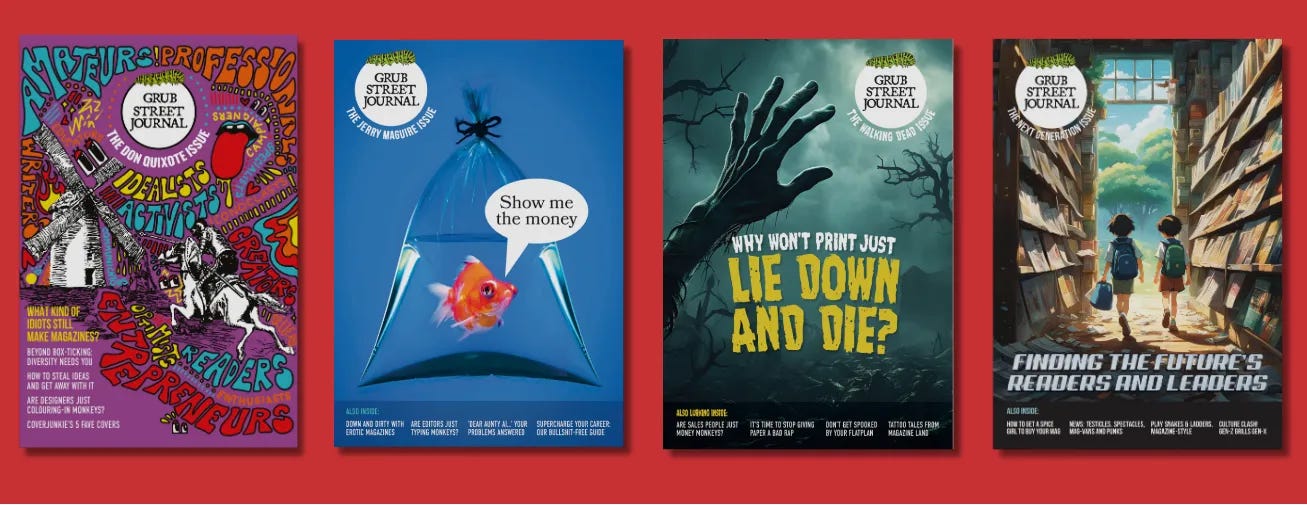Hello magazine makers,
A quick Magazine Diaries update: I think I’ve settled on the formats and timings of my free and paid newsletters.
And not before time.
So, this is my ‘Reading’ newsletter. It will bring you my take on a couple of magazine-making articles that have made me think, with links to some other interesting industry reads further down.
I’ll be sending send this free version of the newsletter out every two weeks.
The plan is then to send a subscriber-only ‘Thinking’ newsletter out on alternate weeks. This will be a longer read from me, highlighting the things that I believe magazine makers need to be thinking about to make their businesses better.
I haven’t turned on payments yet, so the first of my ‘Thinking’ newsletters will go to everyone next week. If you like what you see, hit the pledge button and you’ll be ready to go when I turn payments on at the beginning of April.
Whether you’ve been here since the beginning, or you have just signed up, I’m really keen to know what you think about this evolution of approach.
Comment or hit reply to let me know what you think.
Slàinte Mhath
Peter
Want to know how people are making print magazines work in a digital world? Sign up to get The Magazine Diaries sent straight to your inbox every week.
“If you make yourself essential, you’ll be fine”
Dotdash Meredith is a big player in the US magazine market and when the company’s CEO Neil Vogel talks about what works in magazine publishing, it’s worth listening. I mean, his lastest numbers show turnover up by 5% to $1.8 billion and profits up over 30%.
If you don’t know DDM, it’s a print-digital hybrid formed in 2021 after digital pureplay Dotdash bought magazine giant Meredith for almost $3 billion. Not every Meredith print title survived the acquisition but DDM still publishes half-a-dozen mega brands, including Better Homes & Gardens with a circuation of 3 million and People with 2.5 million regular readers.
Speaking at a Press Gazette event in New York earlier this month, Mr Vogel said:
The basic tenets of media are you have to have great brands, you have to have great audiences, you have to treat them with the utmost respect and love. You will then figure out how to make money…
Pointing to publishing’s problems, he highlighted the twin curses of ‘sentimentality’ and ‘bad business models’ and suggested, “if you’re constantly staring at your own belly button, nothing is going to happen.”
Amen, Neil.
His publishing philosophy seems to boil down to:
If you make yourself essential, you’ll be fine.
For DDM, in verticals like food and drink, beauty and style, travel and entertainment, that means creating content that is intent-based; articles that consumers read when they are intending to do something, usually spending money.
You might not be in those markets, but the idea of being there for readers when they have a very specific itch to scratch is a powerful publishing strategy.
Few of us operate at the scale of DDM, but this is a great read, well worth your time.
Graydon Carter’s ‘golden era’ of magazines
Former Vanity Fair editor Graydon Carter has published a memoir, looking back to a time ‘When the Going Was Good’ and it was possible to secure a $500,000 investment in a magazine idea over dinner.
This is a wonderful long read from Carter’s contemporary, former Sports Illustrated boss Terry McDonnell, reviewing the book but adding context from a time when top editors were known by their first names - Jann, Tina, and Anna - and placing ‘Graydon’ as one of the last of the breed.
McDonnell bounces through Carter’s career: sleeping at his desk at Time; launching Spy, where he labeled a certain yet-to-be President the ‘short-fingered vulgarian’; and the ultimate surprise move to Vanity Fair after being offered the New Yorker on $600,000 a year.
The whole lavish landscape is kind of unimaginable today, not least that Carter paid Norman Mailer $50,000 for an article that he didn’t run. However, the fact that he did it with the full support of Condé Nast boss Si Newhouse spotlights my big takeaway:
Si was building a magazine empire based on quality editorial when, meanwhile, one of the richest and most powerful publishers in the world, Time Inc., was beginning to erode under management increasingly concerned with short-term profits.
The golden era of magazines might be long gone, but the lessons to be learned from its demise are right there for every magazine maker to see.
Is your Grub Street collection complete?
We’ve published four editions of The Grub Street Journal.
The Don Quixote issue: What kind of idiots still make magazines?
The Jerry Maguire issue: Show me the money in magazines
The Walking Dead issue: Why won’t print just lie down and die?
The Next Generation issue: Finding the future’s readers and leaders
Magazine NIBs
✈️Racquet magazine targets the affluent who don’t yet know they love tennis
A high-value audience can be much more valuable than mass scale.
🌄Mr. Magazine™ interviews Mountain Gazette owner & editor, Mike Rogge
“I was determined to interview the experience maker behind Mountain Gazette.”
📉Print circulation across the top 50 US magazines fell 5% year-on-year…
… but The Atlantic managed to increase its overall circulation by 15%.
Magazine Songs
I have a Spotify playlist of songs that reference magazines… What? Music and magazines are two of my favourite things.
This week’s song, ‘America’ by Simon & Garfunkel, was suggested by Kevin at Pitch magazine who reminded me about Kathy reading her magazine on the bus. Simpler times.
If you have a favourite magazine song, comment or reply to this email and I’ll add it to The Grub Street Journal’s ‘Magazine Songs’ playlist.





Nice to see Sue Perkins championing print!
Beautiful read 🤍